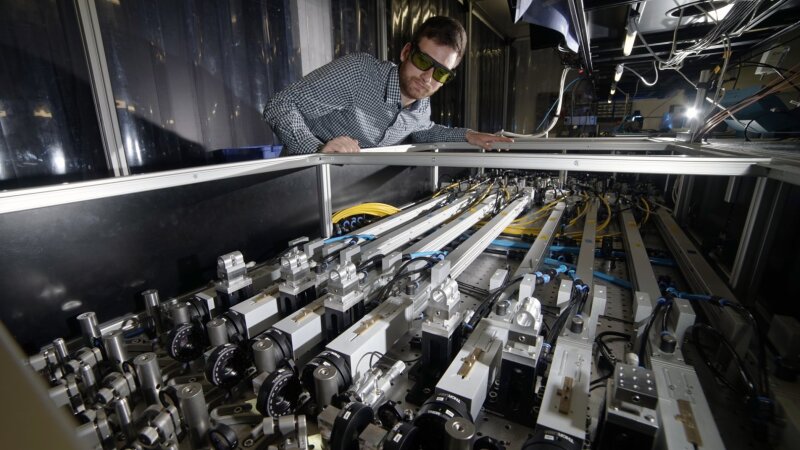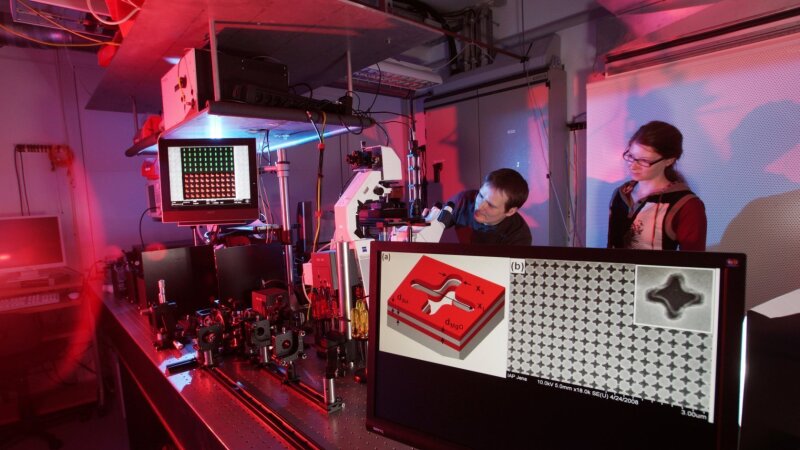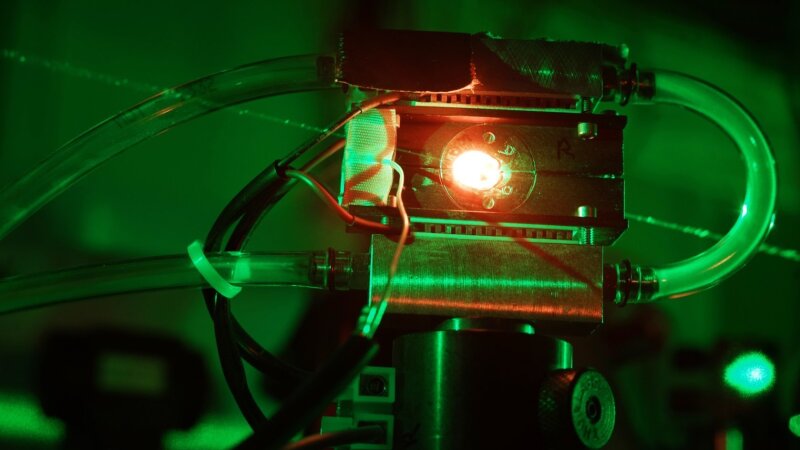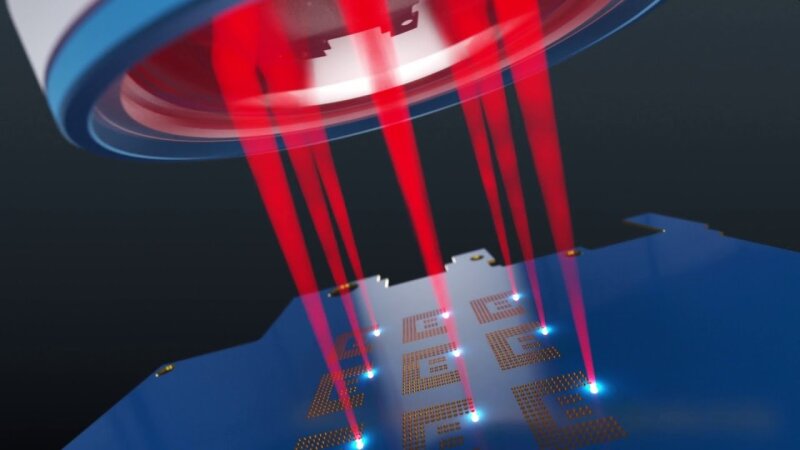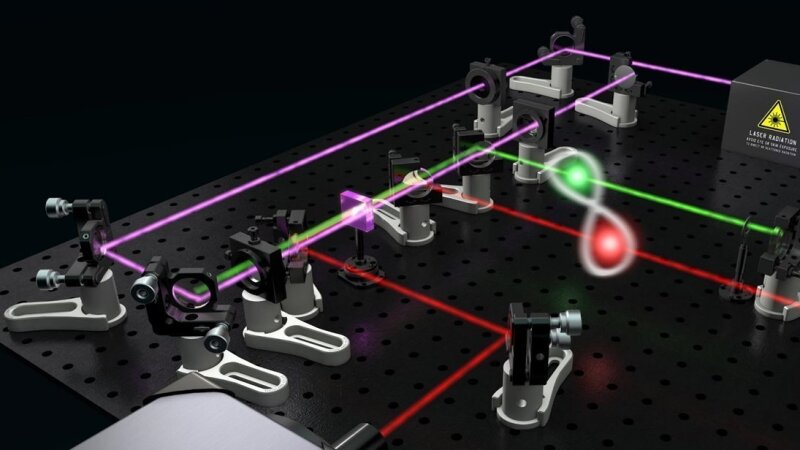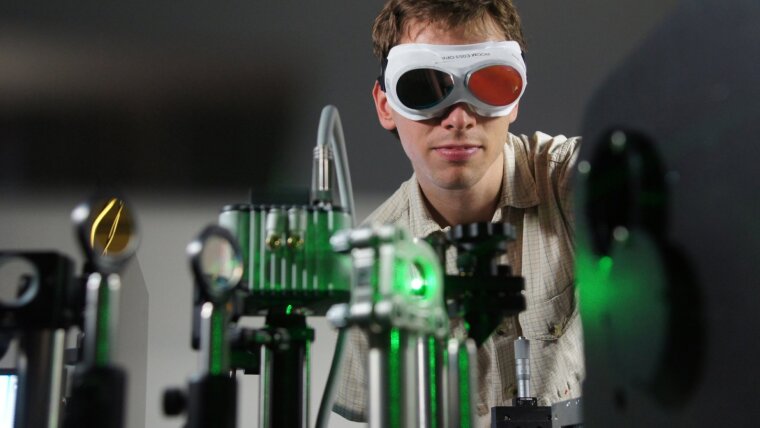
Obtaining a master's degree at the Abbe School of Photonics means to immerse deeply in the rich and stimulating research environment of the Abbe Center of Photonics. Thus, our master's degree students obtain significant hands-on experience during practical modules in state-of-the-art photonics laboratories. By choosing the respective elective modules, our students can specialize in at least one out of five key education areas already during their master's degree studies.
Laser and strong field physics
Together with the global photonics community, we celebrated the 60th anniversary of the invention of the laser in 2020. Based on the quantum-mechanical effect of stimulated emission, which was postulated by Albert Einstein in 1917, the laser has enabled a number of seminal discoveries in modern science over the last decades. Moreover, a considerable market for laser devices has been developed, which is still revolutionizing industrial production and has broad impacts on our daily life.
Fiber laser amplifying system.
Image: Jan-Peter Kasper (University of Jena)Our key education area laser and strong field physics covers activities ranging from the development of lasers able to create extreme intensities (>1020 W/cm2) to ultra-high average powers above the kW barrier. They include the control of laser radiation at ultrafast time scales as well as theoretical and experimental studies on light-matter interactions under extreme conditions and in novel structures. Our education program is based on research which, for example, resulted in the invention and implementation of innovative light sources. These novel sources of light are highly integrated by the use of novel multifunctional components, as they offer some truly remarkable parameters along with flexible properties tailored to application needs. Beyond light sources, we are also exploring fundamentals of light-matter interaction. Specializing in laser and strong field physics allows our graduates to develop new schemes for spectroscopic measurements, material processing, medical treatment, remote sensing, as well as to research at the forefront of the recent findings on spatio-temporal light dynamics and extreme light states.
Nanooptics
Our key education area nanooptics is an approach to understand and master the properties of light and matter at the nanoscale. It is considered to be a major factor of innovation in science and in the economy of this century, since it will enable shrinking and integrating optics to make them compatible with the size of electronics and to realize truly opto-electronic systems. Nowadays, nanooptical research conducts major efforts to provide fundamental understanding as well as key solutions to groundbreaking applications such as light harvesting, nanosized single photon sources, biophotonic sensors, nanoelectronics, and nanomedicine.
Spectroscopic characterization of an artificial nanooptical metamaterail.
Image: Jan-Peter Kasper (University of Jena)State-of-the-art nanofabrication technology allows for the realization of optical structures with sub-wavelength and therefore sub-micron dimensions. These structures can be either tiny photonic components, such as waveguide bends, apertures, microdiscs, and nanoantennae, or they can exhibit periodic arrangements as diffraction gratings, photonic fibers, artificial crystals or metamaterials. In close collaboration between theory, technology, and experiment, the fundamental effects of nanooptics are examined and explored by our scientists and students specializing in nanooptics. Recent research activities of our local scientists targeted the strong coupling of plasmonic nanoantennae to quantum systems, the light-induced self-organization of photonic nanostructures, the synthesis of nano-scaled multiphoton light sources, or the generation and control of diffractionless plasmonic beams, just to mention a few.
Biophotonics
Understanding the origins of diseases, diagnosing them early, and curing them with targeted therapies – these are the visions of contemporary biomedicine. In our key education area biophotonics, light is utilized as a tool to turn these visions into reality. Light enables the examination of life processes in cells, cellular networks, and tissues down to the molecular level and can serve as an ideal tool for in-vivo diagnosis and therapy, paving the way towards minimally invasive medicine.
Frequency doubling in a nonlinear optical crystal.
Image: Jan-Peter Kasper (University of Jena)From a global perspective, biophotonics has already provided major innovations for biomedical research and clinical routine and developed into a coherent scientific discipline of high societal and economic importance. In biomedical research, the recent development of ultrahigh resolution microscopy is providing novel insight into the nanoworld. Students specializing in this area are able to study processes in living cells and the development of diseases in much greater detail. Spectroscopic and multimodal imaging methods contribute complementary information on cell function and metabolism. These findings help in developing targeted therapies that treat diseases directly at their origin – possibly even before manifest symptoms appear. Our biophotonics research explores methods that provide deeper insights into complex biological samples of different size, starting from organs via tissue sections, cells, and viruses, down to DNA and RNA. In clinical routines, photonic technology enables early, sensitive, and accurate recognition of diseases, as well as their gentle treatment. For example, fluorescent imaging has become an important method in the in-vivo detection of cancer and can guide the surgeon with greater precision during operations. Current research aims to refine these techniques and to detect tumors as small as one millimeter in diameter. Marker-free imaging methods, like Raman and near-infrared spectroscopy, are also developing towards in-vivo applications and will provide even more detailed diagnostic information. The research performed by our scientists utilizes and develops these methods according to the needs of pathology, oncology, and other fields.
Optical instrumentation and systems
The success of photonics is inherently connected to the ability to carry new ideas from fundamental studies all the way through to application-oriented developments. Pursuing this path requires substantial expertise to understand, design and realize complex optical instrumentation and systems from the macroscopic to the microscopic scale.
Optical lithography of CMOS components.
Image: Jenoptik AGConsequently, it is not only due to the local history of Ernst Abbe, Otto Schott, and Carl Zeiss that Jena is one of the strongest places for the design and realization of modern optical systems. Our key education area optical instrumentation and systems involves enabling fields such as lens design, aberration theory, system metrology, and performance evaluation as well as novel approaches for electromagnetic wave-based rigorous modeling. The latter is necessary when the applications require pushing the limits of classical optics, i.e. when including diffractive elements in the system. Similarly, our excellent research infrastructure and expertise allows our students to get involved with optical instruments already before graduation. These instruments include lithographically defined diffractive elements, microstructured fibers produced by sophisticated drawing technology, laser written waveguides, free-form surfaces, extreme thin-film technology and optoelectronic signal processing. The resulting optical systems find regular use in such extraordinary applications as real time 3D shape recognition, astronomic instruments for space missions, or in next-generation instruments for gravitational wave detection.
Quantum photonics
The emergence of quantum technology, using the fundamental quantum effects of superposition and entanglement, holds solid promise for a range of breakthrough applications with high societal impact. Specific examples are the encoding of unbreakable messages using quantum cryptography or orders-of-magnitude faster quantum computers. These potentials are recognized worldwide, leading to great strategic funding initiatives, for example in the USA, the European Union and, of course, Germany.
Entangled photons quantum setup.
Illustration: Gilaberte et al., "Video rate imaging with undetected photons," Laser Phot. Rev. 15, 2000327 (2021).At the Abbe School of Photonics, quantum photonics has become a key education area and a major, fascinating field of research. Compared to other international quantum photonics hotspots, Jena's individual strength lies in our demonstrated ability to fuse multiple expertises to integrate available enabling technology into a combined research effort to open up new platforms and integrated systems exploiting quantum technology. One recent example is the generation of non-classical states of light, i.e. photon pairs, by spontaneous nonlinear processes in nonlinear photonic systems ranging from bulk crystals over different waveguide structures to nanostructured or atomically thin surfaces. This understanding can be used to tailor the properties of the generated two-photon quantum states, like spectrum, spatial distribution, and entanglement, to meet the demands of specific applications. Another very active research focus open for specialized graduates in quantum photonics is the development of novel quantum light sources for applications in quantum communication and sensing, efficient processing and detection schemes for high-dimensional quantum information, as well as scalable methods for the transmission of quantum states over long distances.
